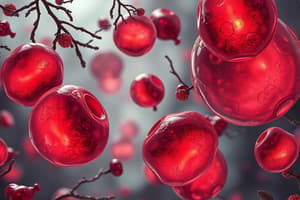Podcast
Questions and Answers
Which of the following is a distinguishing feature of G6PD deficiency?
Which of the following is a distinguishing feature of G6PD deficiency?
- Bite cells in blood film (correct)
- Neonatal jaundice
- Increased RBC proliferation
- Chronic haemolytic anaemia
What is a common precipitating factor for acute haemolysis in individuals with G6PD deficiency?
What is a common precipitating factor for acute haemolysis in individuals with G6PD deficiency?
- Regular exercise
- Vitamin C supplements
- Administration of oxidising drugs (correct)
- Iron supplements
Which statement is true regarding the blood count in G6PD deficiency?
Which statement is true regarding the blood count in G6PD deficiency?
- It shows neutropenia during an attack
- It displays increased platelet levels
- It is always abnormal
- It remains normal between attacks (correct)
What is typically seen in the blood film of a patient with G6PD deficiency during an acute attack?
What is typically seen in the blood film of a patient with G6PD deficiency during an acute attack?
What is the primary treatment approach for individuals with G6PD deficiency?
What is the primary treatment approach for individuals with G6PD deficiency?
What is the chief red blood cell (RBC) enzyme defect in G6PD deficiency?
What is the chief red blood cell (RBC) enzyme defect in G6PD deficiency?
Which population is predominantly affected by G6PD deficiency?
Which population is predominantly affected by G6PD deficiency?
How does G6PD deficiency lead to hemolysis?
How does G6PD deficiency lead to hemolysis?
What is the most common G6PD variant with normal activity?
What is the most common G6PD variant with normal activity?
Which region shows a high prevalence of G6PD deficiency?
Which region shows a high prevalence of G6PD deficiency?
What clinical consequence is associated with the Mediterranean type of G6PD deficiency?
What clinical consequence is associated with the Mediterranean type of G6PD deficiency?
What is the pathogenesis of anaemia of chronic diseases?
What is the pathogenesis of anaemia of chronic diseases?
Which laboratory feature is typically seen in anaemia of chronic diseases?
Which laboratory feature is typically seen in anaemia of chronic diseases?
What distinguishes pure red cell aplasia from aplastic anaemia?
What distinguishes pure red cell aplasia from aplastic anaemia?
Which is a common cause of aplastic anaemia?
Which is a common cause of aplastic anaemia?
What is the molecular basis of sickle cell disease?
What is the molecular basis of sickle cell disease?
What is a characteristic clinical feature of sickle cell disease?
What is a characteristic clinical feature of sickle cell disease?
What is the main pathology seen in thalassaemias?
What is the main pathology seen in thalassaemias?
Which type of thalassaemia presents with severe anaemia from infancy and splenomegaly?
Which type of thalassaemia presents with severe anaemia from infancy and splenomegaly?
What is the characteristic blood picture in thalassaemias?
What is the characteristic blood picture in thalassaemias?
What is the primary treatment for aplastic anaemia?
What is the primary treatment for aplastic anaemia?
G6PD deficiency can lead to acute haemolysis, which can be triggered by ingestion of red beans.
G6PD deficiency can lead to acute haemolysis, which can be triggered by ingestion of red beans.
Chronic haemolytic anaemia is a common clinical manifestation of G6PD deficiency.
Chronic haemolytic anaemia is a common clinical manifestation of G6PD deficiency.
During an acute attack in G6PD deficiency, the blood film may show schistocytes.
During an acute attack in G6PD deficiency, the blood film may show schistocytes.
Aplastic anaemia usually presents with bone marrow hypercellularity.
Aplastic anaemia usually presents with bone marrow hypercellularity.
Treatment for G6PD deficiency includes promoting the intake of oxidising drugs.
Treatment for G6PD deficiency includes promoting the intake of oxidising drugs.
G6PD deficiency is the most common red cell enzyme defect, affecting primarily females.
G6PD deficiency is the most common red cell enzyme defect, affecting primarily females.
Glucose-6-phosphate dehydrogenase (G6PD) deficiency leads to an increase in the ability of red blood cells to protect against oxidative injuries.
Glucose-6-phosphate dehydrogenase (G6PD) deficiency leads to an increase in the ability of red blood cells to protect against oxidative injuries.
African (A-) type G6PD deficiency is associated with severe clinical consequences compared to the Mediterranean type.
African (A-) type G6PD deficiency is associated with severe clinical consequences compared to the Mediterranean type.
Over 400 G6PD variants have been identified, with the most common types having reduced enzyme activity.
Over 400 G6PD variants have been identified, with the most common types having reduced enzyme activity.
Glucose-6-phosphate dehydrogenase (G6PD) deficiency affects approximately 100 million people globally, with a higher prevalence in Asia and the Americas.
Glucose-6-phosphate dehydrogenase (G6PD) deficiency affects approximately 100 million people globally, with a higher prevalence in Asia and the Americas.
G6PD deficiency impairs the function of glutathione reductase in maintaining glutathione in its oxidized state (GSSG).
G6PD deficiency impairs the function of glutathione reductase in maintaining glutathione in its oxidized state (GSSG).
Anaemia of chronic diseases is always associated with chronic microbial infections.
Anaemia of chronic diseases is always associated with chronic microbial infections.
Aplastic anaemia is commonly inherited and rarely acquired.
Aplastic anaemia is commonly inherited and rarely acquired.
Homozygous inheritance of a gene coding for a haemoglobin variant (HbS) causes sickle cell disease.
Homozygous inheritance of a gene coding for a haemoglobin variant (HbS) causes sickle cell disease.
Sickle cell trait presents with symptoms while the heterozygous state does not.
Sickle cell trait presents with symptoms while the heterozygous state does not.
Thalassaemia is characterized by excessive production of globin chains in RBCs.
Thalassaemia is characterized by excessive production of globin chains in RBCs.
In aplastic anaemia, bone marrow examination typically shows excessive cellularity.
In aplastic anaemia, bone marrow examination typically shows excessive cellularity.
Anemia of chronic diseases is typically characterized by serum iron and total iron binding capacity both being elevated.
Anemia of chronic diseases is typically characterized by serum iron and total iron binding capacity both being elevated.
Aplastic anaemia is caused by physical agents such as hepatitis viral infections.
Aplastic anaemia is caused by physical agents such as hepatitis viral infections.
Aplastic anaemia is primarily treated with withdrawal of the offending agent.
Aplastic anaemia is primarily treated with withdrawal of the offending agent.
Abnormal ß globin chain structure leads to thalassaemia.
Abnormal ß globin chain structure leads to thalassaemia.
Flashcards are hidden until you start studying
Study Notes
- Anaemia of chronic diseases is common and associated with reduced red blood cell (RBC) proliferation and impaired iron utilization, often seen in chronic infections, immune disorders, and neoplasms.
- The pathogenesis of anaemia of chronic diseases involves cytokine-driven inhibition of RBC production, leading to decreased iron release and erythropoietin (EPO) production.
- Laboratory features of anaemia of chronic diseases include low serum iron, reduced total iron binding capacity, and increased storage iron in marrow macrophages, with normocytic or microcytic red cells.
- Treatment for anaemia of chronic diseases focuses on addressing the underlying condition, with some patients benefiting from EPO therapy.
- Aplastic anaemia is characterized by pancytopenia and bone marrow hypocellularity, which can be inherited or acquired, often due to stem cell failure or suppression.
- Major causes of aplastic anaemia include idiopathic factors, chemical agents, physical agents, viral infections, and miscellaneous factors.
- Clinical features of aplastic anaemia include symptoms related to deficiencies in red blood cells, white blood cells, and platelets, along with physical signs like bruising and bleeding gums.
- Management of aplastic anaemia involves supportive care, withdrawal of offending agents, and specific treatments like bone marrow transplantation or immunosuppressive therapy.
- Haemoglobin abnormalities like sickle cell disease and thalassaemias are caused by abnormal globin chain production, leading to characteristic blood picture and clinical manifestations.
- Sickle cell disease results from a single point mutation causing abnormal ß globin chains, leading to tissue infarction, vaso-occlusive crises, chronic hemolysis, and management focusing on symptom control and prevention.
- Thalassaemias result from imbalanced globin chain production, with main types including ß-thalassaemia major, ß-thalassaemia minor, and α-thalassaemia, diagnosed through blood tests and hemoglobin electrophoresis.
- Red cell enzyme deficiencies, like Glucose-6-phosphate dehydrogenase (G6PD) deficiency, can lead to hemolytic anaemia by reducing the RBCs' ability to protect against oxidative injuries.
- G6PD deficiency is an X-linked trait affecting mainly males in certain regions, with various genetic variants impacting enzyme activity, leading to clinical manifestations like neonatal jaundice and hemolysis triggered by certain factors.
- Diagnosis of G6PD deficiency involves blood tests during attacks showing characteristic blood film findings like bite cells and blister cells, with treatment focusing on avoiding triggers and managing underlying infections.
Studying That Suits You
Use AI to generate personalized quizzes and flashcards to suit your learning preferences.




